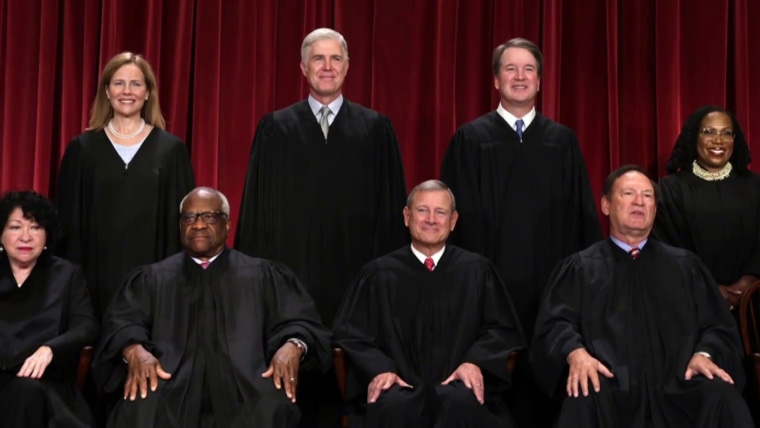The announcement Monday that the U.S. Supreme Court, for the first time ever, has adopted a code of conduct comes after months, if not years, of criticism of the court. The announcement shows that public pressure matters. But the fact that the code has no enforcement mechanism demonstrates that, at least for now, public pressure pushed the justices only so far.
The fact that the code has no enforcement mechanism demonstrates that, at least for now, public pressure pushed the justices only so far.
To be sure, the court wouldn’t have adopted this code were it not for the drip, drip, drip of ethics scandals facing current members, Justice Clarence Thomas especially. As ProPublica reported, Republican megadonor Harlan Crow funded Thomas’ luxurious trips, tuition for his great-nephew and the purchase of Thomas’ mother’s house. Somewhat similarly, ProPublica reported that hedge fund billionaire Paul Singer helped fund a 2008 trip Justice Samuel Alito took to Alaska. A 2014 case, which Alito took part in, involved a dispute Singer’s hedge fund had with Argentina. And just this year, The Associated Press reported that Justice Sonia Sotomayor’s court staff essentially strong-armed schools and libraries into purchasing her book.
Let’s also be clear that the court didn’t want to do this. In a 158-word “statement of the court” that precedes its new code, the tone the court adopts right off the bat is that really this is all our fault. It’s our fault, the statement suggests, for being so confused as to think that because they’re the only nine federal judges in the country not subject to a binding code of conduct, some act as if they’re not subject to a binding code of conduct. That “statement of the court” is really just a defensive introduction to what follows. Within that 158-word section, the word “misunderstanding,” meaning our so-called misunderstanding, appears twice.
It is our fault, the statement says, for having the “misunderstanding” that Supreme Court justices “regard themselves as unrestricted by any ethics rules.” This appears to be a bit of a straw man. Because the justices were not, in fact, restricted by the same ethics rules as other federal judges. What the justices are really trying to argue is that it’s our fault for thinking they act like they’re not subject to a binding code of ethics. But here, again, reality gets in the way. The reality is that the justices have accepted, and at times have failed to disclose, gifts from donors, including at least one with business before the court. If the code of conduct applied to the justices, this behavior would raise serious concerns.
The court also went to pains to tell us that while we, the public, forced it into doing this, “for the most part these rules and principles are not new.” According to the court, it has always been guided by “the equivalent of common law ethics rules,” the code of conduct that applies to every other federal judge in this country, ethics advisory opinions and “historic practice.” In case we missed it the first time, the court then reminds us that the code is “largely” just a “codification of principles that we have long regarded as governing our conduct.”

The court is right: There isn’t much new here. Justices are committing themselves to conduct themselves so that parties before them, and the public at large, think they’re getting a fair shake. The new code includes five canons, including cautions to avoid “impropriety and the appearance of impropriety,” outside activities that are inconsistent with “the obligations of the judicial office” and political activities. The code includes specific guidance for the justices about how to adhere to it.
Perhaps the biggest tell here that the court was forced kicking and screaming into giving us something is that it hasn’t given us much of anything. There’s no enforcement mechanism for this code of conduct. By definition, creating an enforcement mechanism for a code of conduct that applies to the highest judges in the land can raise some practical concerns. But, legally speaking, it seems to be entirely permissible for the Supreme Court itself to appoint an Article III inspector general to ensure that the code is followed. Legal questions related to the separation of powers would arise if Congress, not the court, created the code and/or its enforcement mechanism.
Perhaps the biggest tell here that the court was forced kicking and screaming into giving us something is that it hasn’t given us much of anything.
In sum, what we have here is a unanimous decision by the Supreme Court that is, more than anything else, a tacit acknowledgment that the court’s approval rating is near its all-time low. It’s impossible to disentangle the lack of faith in the court from the ethics scandals plaguing the court. And so it’s easy to see why the court thinks a code of ethics is just what the doctor ordered. But without an enforcement mechanism, what we have today is almost identical to what we had yesterday: an assurance by the court that justices will act according to certain ethical standards.
It’s the argument that the court has already been doing so that’s the real LOL.

